MARIANI’S
January
11, 2009
NEWSLETTER
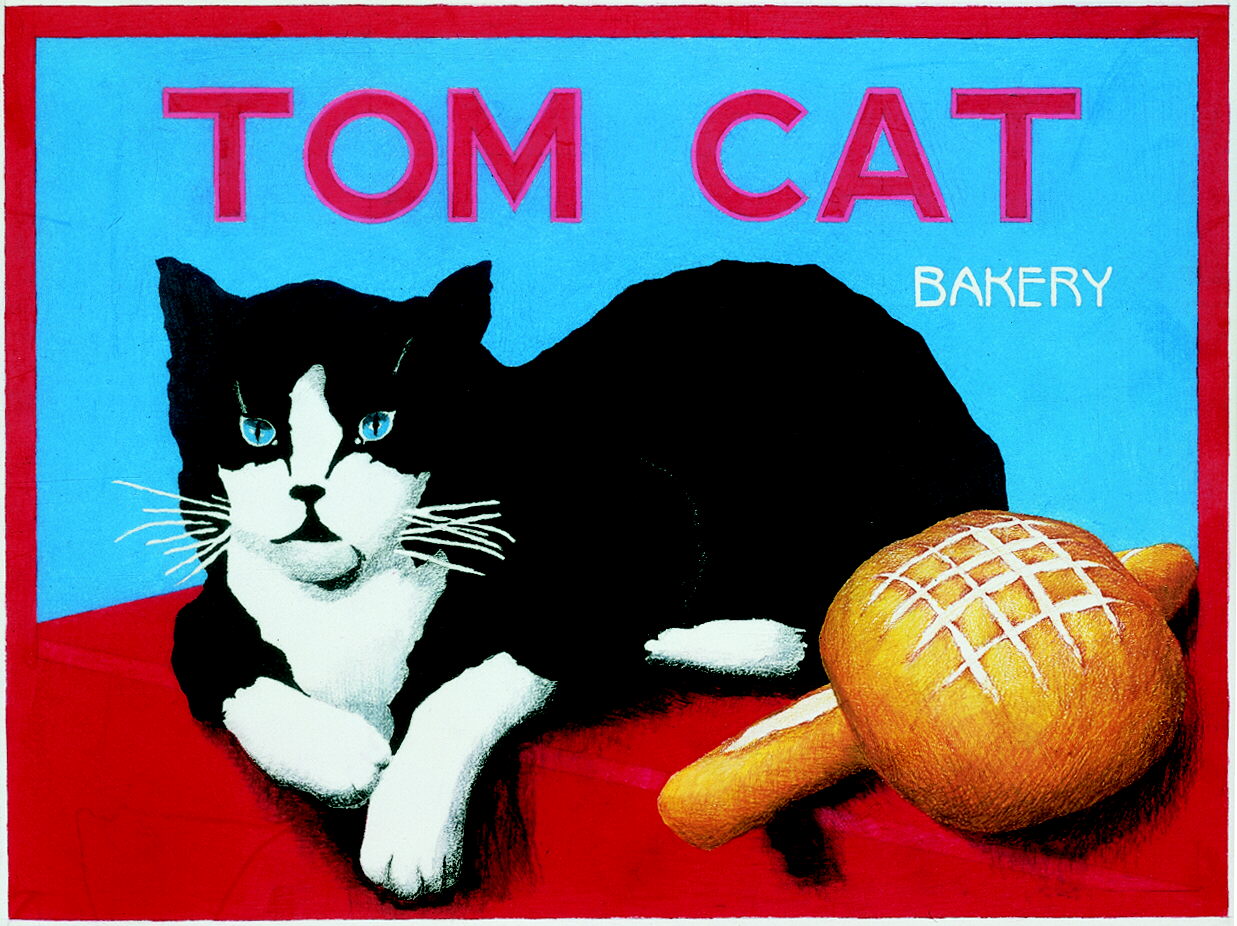
Tom
Cat Bakery, Long Island City, NY
~~~~~~~~~~~~~~~~~~~~~~~~~~~~
SUBSCRIBE AND
UN-SUBSCRIBE: You may subscribe anyone you wish
to this newsletter--free of charge--by
clicking here.
ARCHIVE: Readers may access
an
Archive of all past newsletters--each annotated--dating back to July,
2003, by simply clicking on www.johnmariani.com/archive
To Read my
article on Dining Out in Santa
Fe, NM,
in this month's Diversion
Magazine, click
here.
~~~~~~~~~~~~~~~~~~~~~~~~~~~~~~~~~~~~~
In
This Issue
WHAT
IS HAPPENING IN VEGAS?
by John A. Curtas
NEW
YORK CORNER: La Masseria
Triumphs by John Mariani
NOTES
FROM THE WINE CELLAR: My 10
Favorite (Affordable) Wines of 2008
by John Mariani
QUICK BYTES
~~~~~~~~~~~~~~~~~~~~~~~~~~~~~~~~~

by John A. Curtas
The
headline in Nation’s
Restaurant News in June
said: “Vegas refuses to fold as economy craps out.” By late September
that same banner read: “Hard luck befalls Las Vegas following U.S.
housing bust.” The first article was full of quotes from the usual
celebrity suspects and their flacks about how things weren’t as bad as
they seem. Three months later, every one of them admitted business is
down (in food and beverage up and down The Strip) around 16% from a
year ago. Off the record, a number of the more prominent restaurateurs
have told me the figure is closer to 20%.
Louis Osteen closed Louis’ and Louis’ Fish Camp last month, and a
month earlier, Joseph Keller quietly shuttered Bistro Zinc at Lake Las Vegas. The
venerable André’s downtown
is
history and a number of places in the (overbuilt) Palazzo (15
mid-to-high-end restaurants opened there in early ‘08) are said to be
hanging on by the skin of their teeth. As of this writing, Mainland has closed, and more
shutterings are rumored to be in the works.
All of this bodes well for diners, as early
bird specials, bargain prix fixes, and reduced wine prices are showing
up in places everywhere but Joël
Robuchon (right) and Guy Savoy
(and Savoy has his Bites and Bubbles bar menu, and a wine list that
seems to have more good bottles under $100 than ever). Most well-known
places from Mario Batali’s Carnevino
to Bradley Ogden have quietly
cut their prices from 5-10% in the past six months, and consumers can
expect these reductions to hold steady in the near future.
Into this mix comes Steve Wynn’s Encore; opening at the
end of 2008 – with five new restaurants -- three of which are aimed at
the fine dining crowd: Sinatra’s
(Chef Theo Schoenegger); Botero Steak
(Chef Mark Lo Russo); Switch
(Chef Mark Poidevin). How these will fare in an already crowded (and
much less profitable) field, should be most interesting to watch. The
Wynn has already scuttled plans to open Larry Forgione’s An American
Place, in the space housing Tableau.
As of a month ago, Forgione was hard at the stoves at Tableau as its
Executive Chef, updating and revising its menu, but not
getting his signature restaurant name on the door. Yes, times are tough
all around, and 2009 should prove a most interesting year for the Vegas
dining scene.
If
one kind of food seems to be holding its own in Vegas, it might well be
sushi. Of course, sushi jumped the shark a long time ago. It
maintained a slice of its dignity throughout the ‘90’s, but by the turn
of the century it crossed the pizza line, never to return to what it is
supposed to be. I remember being amused the first time I saw sushi
rolls (maki-zushi) in Trader
Joe’s ten years ago, just as I recall being horrified when they became
staples in the isles of Costco and Wal-Mart around 2005.
Like pizza, sushi, in its native and
best form, is about the combination of a few, pristine ingredients into
something far greater than the sum of its parts. And like the cheap
cheese, doughy, over-thick bread concoction that pizza has become,
sushi in America is now so far removed from whence it came that it
can’t even remember its roots, much less try to respect them. And like
pizza, the entire cult of raw fish has become so twisted that it no
longer matters whether it’s any good or not.
Sushi literally means: “it’s sour” and refers
to the rice not the fish. Just as Vera Pizza Napoletana (certified
authentic Italian pizza) is more about the dough than the toppings upon
it; sushi is supposed to be about the rice at least as much as the fish
garnishing it, something that’s become lost in this race to the bottom
of the ocean. Connoisseurs look for and praise the taste and texture of
the sumeshi (vinegared sushi
rice) as the true star of sushi. That rice is always the starchy,
short-grained Japonica rice to which sake, rice vinegar, sugar, salt
and sometimes kelp are added. Americans who praise huge slices of fish
on tightly packed, gummy rice are missing the whole point.
Reviewing modern American “sushi” restaurants
with an awareness of what sushi is supposed to be like is like
critiquing "The Dukes of Hazzard" through the prism of "Citizen
Kane." Nevertheless, two sushi restaurants opened recently in Las
Vegas, within weeks of each other, in two of the most prominent hotels,
and the menus of each may help explain just what makes this food so
irresistible to the American palate.
SUSHISAMBA
Palazzo Hotel and Casino
3265 Las Vegas Blvd. South
702-607-0700
www.sushisamba.com
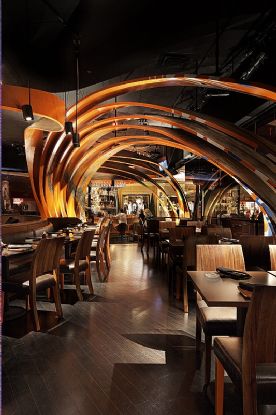 Sushi
Samba, part of a global chain, in The Palazzo is practically the poster
restaurant for how illegitimate sushi and sashimi menus have become. Is
it a Japanese restaurant? A Brazilian churrascaria? A Peruvian-fusion
ceviche joint? Who knows? You certainly won’t after a meal there, and I
couldn’t figure it out after three.
Sushi
Samba, part of a global chain, in The Palazzo is practically the poster
restaurant for how illegitimate sushi and sashimi menus have become. Is
it a Japanese restaurant? A Brazilian churrascaria? A Peruvian-fusion
ceviche joint? Who knows? You certainly won’t after a meal there, and I
couldn’t figure it out after three.
The true (?) sushi options are
relegated to the back pages of the book-like menu while five sashimi
ceviches (?) and four sashimi tiraditos
are pushed front and center. The difference between the
ceviches and the tiraditos is
the ceviches contain slabs of in-artfully sliced raw fish, whereas the tiraditos toss them and sauce them (tirado means “to throw”) with
orange and mustard miso, yuzu
and (tasteless) black truffle oil, and jalapeño and lemongrass.
None of these overwrought concoctions are awful, but they have as much
to do with true sashimi and ceviche as a turkey burger does with a
Butterball. The sashimi ceviche, besides being a contradiction in
terms, lay out the fish in cut strips on the plate while it sauces them
with everything from ginger/garlic/soy to passion fruit cucumber and
cilantro. They look like overlarge strips of raw fish and taste like
something an impressionable cook would throw together after one trip to
Nobu. It’s all very hip and trendy, but in the hands of novices, flavor
distinctions are obliterated by the drenching they take from all that
citrus.
Even more disappointing is the
garden-variety sushi offered. Snaking your way to the sushi bar, you
will be assaulted by incessant samba music and non-stop, soft porn
videos that appear to be celebrating womanhood in all its worldly
guises, but which, in fact, exploit the semi-nude female form in a
number of ways. Whether you think this is prurient and voyeuristic, or
au courant, probably depends upon the number of tattoos and piercings
you have.
Once you find a spot at the sushi “bar”
you’ll notice three things; one: the refrigerator case facing you is
dirty inside and out; two: the small amount of fish inside that case is
so tired and dried out you’d swear you were in some cheap,
all-you-can-eat joint; and three: the sushi chefs are elevated two feet
above you, making interaction with them impossible. Not that you’d want
interaction with chefs who present Japanese snapper (madai), so crudely cut it looks
like it was sliced with a butter knife, or a hotate (scallop) that is oversized,
tasteless and gummy. Equally bad were Japanese mackerel tasting of
cheap, pickled herring, salty and stale ikura (salmon roe), and a salmon
and avocado roll that tasted of neither.
When it comes to cooked food, the
kitchen at Sushi Samba is particularly fond of sweet miso glaze, so
expect that slick red bean paste to show up on everything from lamb
chops to sea bass to a Berkshire pork belly with butterscotch miso. All
are decently prepared, but before you get to them you’ll have to fight
through the “taquitos” –
perhaps the worst use of the hard taco shell since an Old El Paso
slashed the roof of my mouth twenty years ago. Here, they get loaded
with lobster, yellowtail and spicy tuna, to no great effect – other
than to threaten your mandibular safety – and come with a spicy aji panca (Peruvian chile) sauce
with, yet again, more lime.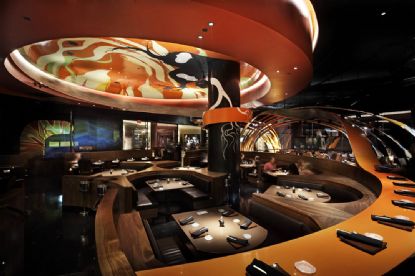
Among
the truly awful fusion-food fiascoes are quinotto (creamy Peruvian
quinoa with barley, Manchego cheese, wild mushrooms and (once again)
tasteless fresh herbs, a dish that looks like something the baby
upchucked and smells barely better, and “El Topo,” a “samba” roll
containing salmon jalapeño, shiso
leaf, melted mozzarella and crispy onion. The Neo Tokyo roll is a
garden variety spicy tuna roll – for fifteen dollars – and the tatami iwashi (crispy dried sheets
of pressed sardines) are greasy highway robbery at ten bucks a bucket.
If all of that isn’t enough to pique
your interest, there are also twenty-two robata-grilled dishes, and a
complete lineup of Brazilian steakhouse (churrasco) items. Whew! The
bottom line: Sushi Samba is trying to be so many things it isn’t really
good at any of them. But it’s been packed from the get-go by hipsters
(and hipster-wannabes) who want to believe the food is much better than
it really is. My guess is they also want to believe they’re eating
fresh, healthy, authentic Japanese and Japanese/fusion food – and
they’re not doing that either.
Sushi and sashimi are priced between $6-12 for two pieces, and $4-17
for individual cut or hand rolls, ceviches and tiraditos. “samba rolls”
are priced between $10-20. A full meal including non-sushi items will
run at least $150 for two.
yell●wtail
Bellagio Resort and Casino
3600 Las Vegas Blvd. South
702-693-8300
www.lightgroup.com
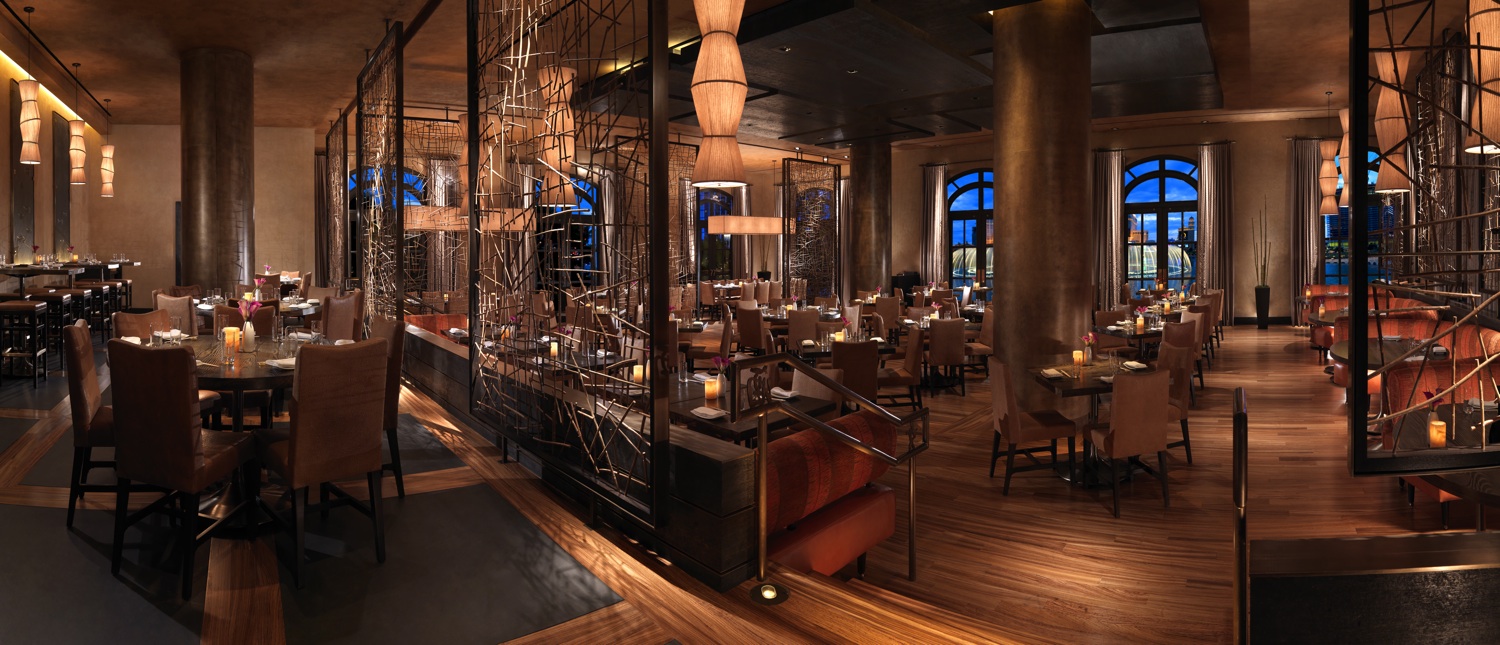 Yellowtail
in the Bellagio is another creation from The Light Group,
nightclub impresarios who now run six food and beverage outlets in that
hotel alone, along with several others around town. Like the
Wolfgang Puck Fine Dining Group, it runs a tight ship in all of its
outposts, and rarely puts forth food that feels commercialized or
by-the-numbers. Make no mistake though, like Sushi Samba, this is a
corporate food factory, designed and planned to the nines; calculated
at every turn to appeal to the zeitgeist of how modern America eats.
And like Sushi Samba, it’s next door to a nightclub, so many of its
customers are of that ilk.
Yellowtail
in the Bellagio is another creation from The Light Group,
nightclub impresarios who now run six food and beverage outlets in that
hotel alone, along with several others around town. Like the
Wolfgang Puck Fine Dining Group, it runs a tight ship in all of its
outposts, and rarely puts forth food that feels commercialized or
by-the-numbers. Make no mistake though, like Sushi Samba, this is a
corporate food factory, designed and planned to the nines; calculated
at every turn to appeal to the zeitgeist of how modern America eats.
And like Sushi Samba, it’s next door to a nightclub, so many of its
customers are of that ilk.Happily, the sushi and sashimi here are far superior in quality to that served a mile down the street. Chef Akira Back’s menu runs to two manageable pages – not six overloaded ones – and it contains many more hits than misses. The left side contains two categories: "Cool Shared Plates" and "Warm Shared Plates." On the cool side, the ballyhooed "Big Eye Tuna pizza" contains substantial amounts of good quality fish on a crispy crust garnished with micro-shiso leaf, which is then unnecessarily dabbled with (the much maligned, for good reason) truffle oil. Better is "scallop Peru" -- more akin to true ceviche, with thinly sliced scallops being lightly bathed in yuzu and sriracha that highlight and don’t overwhelm the flavors. Lobster carpaccio also respects the main ingredient, allowing it to be accented, not overwhelmed, by the cilantro, onion and ponzu sauce with which it shares the plate.
Not quite as successful is warm Scottish salmon – a seared chunk of high quality fish that gains nothing from being underneath a rice cracker and lightly sauced with a Japanese “hollandaise.” At $30, it comes to about ten bucks a bite. The “Signature” Lobster Roll is wrapped with asparagus and garnished with tasteless prosciutto that brings nothing to the party. Between this and the truffle oil pizza misfire, it might be a good idea for the kitchen to stick to its Asian roots and forget about Europe for a while.
Some fusion items work beautifully here: a baked crab hand roll with fried onions (more like a slimmed down mini-burrito wrapped in a strangely soft and tasty soy paper wrapper), and a crispy pork belly roll that displays enough non-Japanese unctuousness to satisfy any bacon lover. Equally rich are the two bites of just-grilled Kurasowa Black River (true) Kobe beef. At $42 an ounce, three slices are more than enough to appreciate this beef’s gamy decadence.
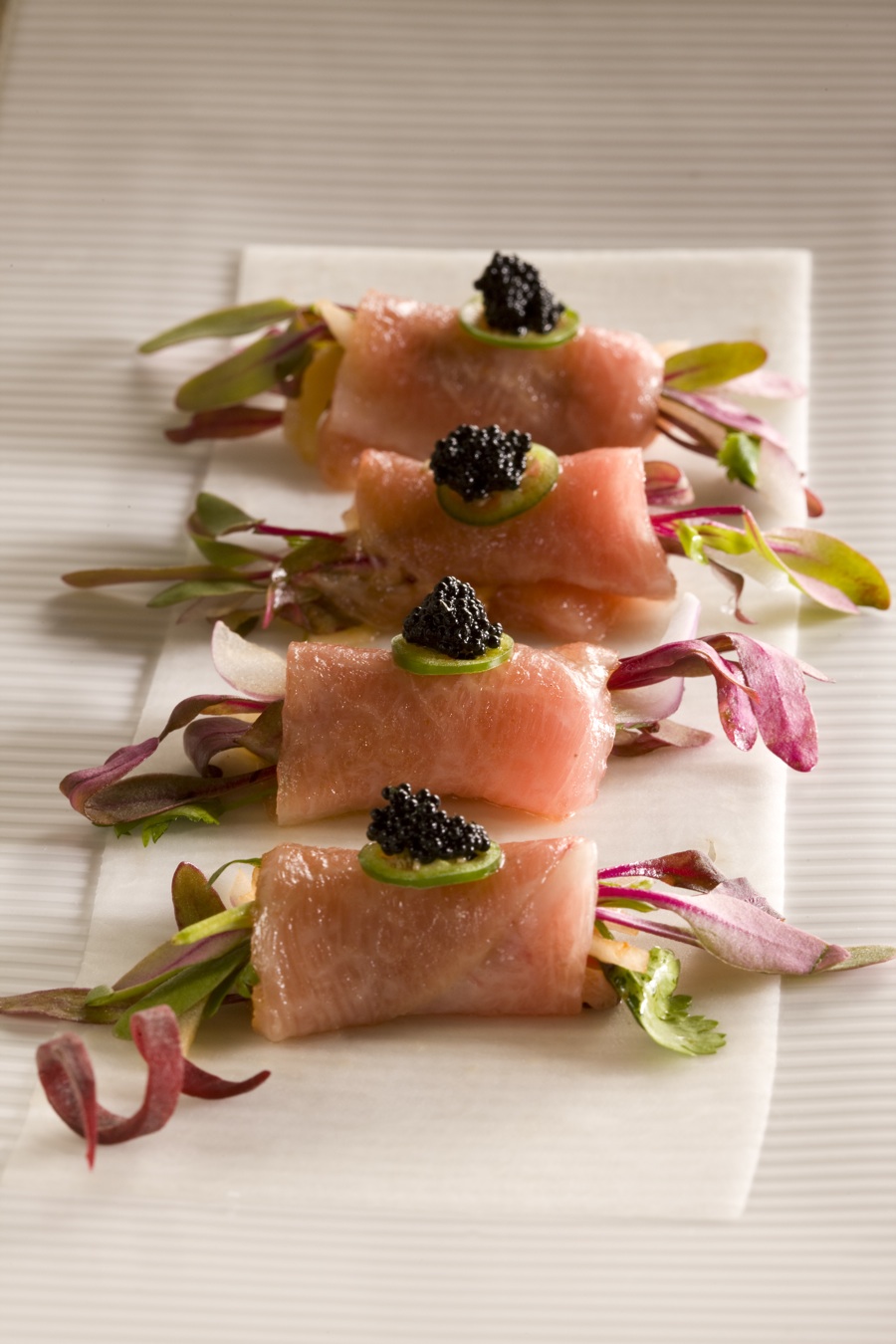
Yellowtail shines with its sushi even though it has no sushi bar per se. Everything is ordered off menu and composed out-of-sight, but the fish is artfully sliced, the right size, firm to the bite, and not burdened by anyone’s attempt to jazz it up. A plate of signature sushi items holds delicate, lightly seared toro of good quality, kimedai (Japanese Golden Eye snapper), braided kohada (barely marinated sardines that don’t taste like cheap, pickled herring), firm and chewy mizukado (octopus) and a Santa Barbara prawn that tastes as if it had been caught that morning. The rice is delicate, the right size, shaped well, slightly warm and full of infused-flavor. None of these competes with a top-of-the-line sushi boutique on either coast, but for a volume restaurant in a large hotel, you would be hard pressed to find better seafood or presentation.
If you ask for a whole sea sea urchin and they’re available, Back will parade one to your table, accompanied by long, thin slices of snow white yari ika – a skinny needle squid that at first feels chalky in your mouth, then melts on your tongue after a slight dip in dashi broth. The flavor contrast between it and the funk, salt and dankness of the urchin stays will remain in your taste memory long after you’ve left the restaurant.
Back’s tamago -- a small, sweet square omelet – is a worthy finish to your meal. He told me it is one of the yardsticks to measure the skill of a Japanese chef, and took him seven years to perfect. Japanese food can sometimes be subtle to the point of invisibility, but one bite of this airy, flour-less, sweet, egg-y creation is a good start to appreciating the most inscrutable of the world’s cuisines.
Like Akira Back’s tamago, sushi is a deceptively simple art. As America slowly weans itself from its steak and starch roots, sushi provides a food that, in its purest form, provides a healthful alternative to the way we used to eat. But as with most things edible, our cultural melting pot is not content to let something so pure remain just that. Americans seem to be more in love with the idea of sushi rather than in the execution thereof, and as long as seafood remains cheap, they will flock to this newest fad at the bidding of restaurateurs who are more than willing to cheapen and bastardize it in order to exploit its popularity. Thankfully some restaurants – even one in a huge Las Vegas hotel – have enough respect for what sushi should be to hold the line a while longer. Oscar Wilde once said: “The truth is rarely pure and never simple.” Sadly, the future of sushi is to remain neither.
Sushi and sashimi run between $7-12 for two pieces, with toro belly being much higher. Hand, cut and specialty rolls are priced between $5-25. Back’s omakase is $100/person with a $55 supplement for a sake and wine pairing.
John
A. Curtas has since 1995 has been commenting on the Las Vegas food
scene and reviewing restaurants for Nevada Public Radio. He is
also
the restaurant critic for KLAS TV, Channel 8 in Las Vegas, and his past
reviews can be accessed at KNPR.org.
~~~~~~~~~~~~~~~~~~~~~~~~~~
NEW
YORK CORNER
by John Mariani
LA
MASSERIA
235 W 48th
Street (near Eighth Avenue)
212-582-2111
www.lamasserianyc.com
After
four years, La Masseria has emerged as one of New York's very finest
Italian ristoranti. Not
that
it wasn't the day it opened, in 2004,
when I picked it as one the best new restaurants of that year in
America. But quietly, devoted to its faithful clientele and each
day introducing more and more signature dishes and regionality, La
Masseria now ranks at the very top rank of la cucina Italiana new york--and
given the presence of such great examples as Felidia, San Pietro, Il
Posto, Convivio, Scarpetta, and Fiamma--along with any number of
wonderful trattorias, it is testament to the extraordinary, day-to-day
devotion of owners Giuseppe "Peppe" Iuele and Enzo Ruggiero with
chef-partner Giuseppe Coladonato.
La Masseria (which means "the
farmhouse") is a beautiful restaurant in the Theater District done in a
winning combination
of arched ceilings, farm utensils, photos and artwork, aged wood,
and the modernity of iron sconces, stonework, and wine bins, all
designed by Libby Langdon. To the front is a good bar, windows
overlook the street, and the main dining room (above) leads to a
smaller party room. Tables are well set and stemware of fine
quality. The noise level is entirely civilized for good
conversation. The service staff is professional and friendly,
knowledgeable and always helpful, never intrusive but always there at a
nod, led with affable spirit by Peppe and Enzo, boyhood friends from
Capri. The winelist gets 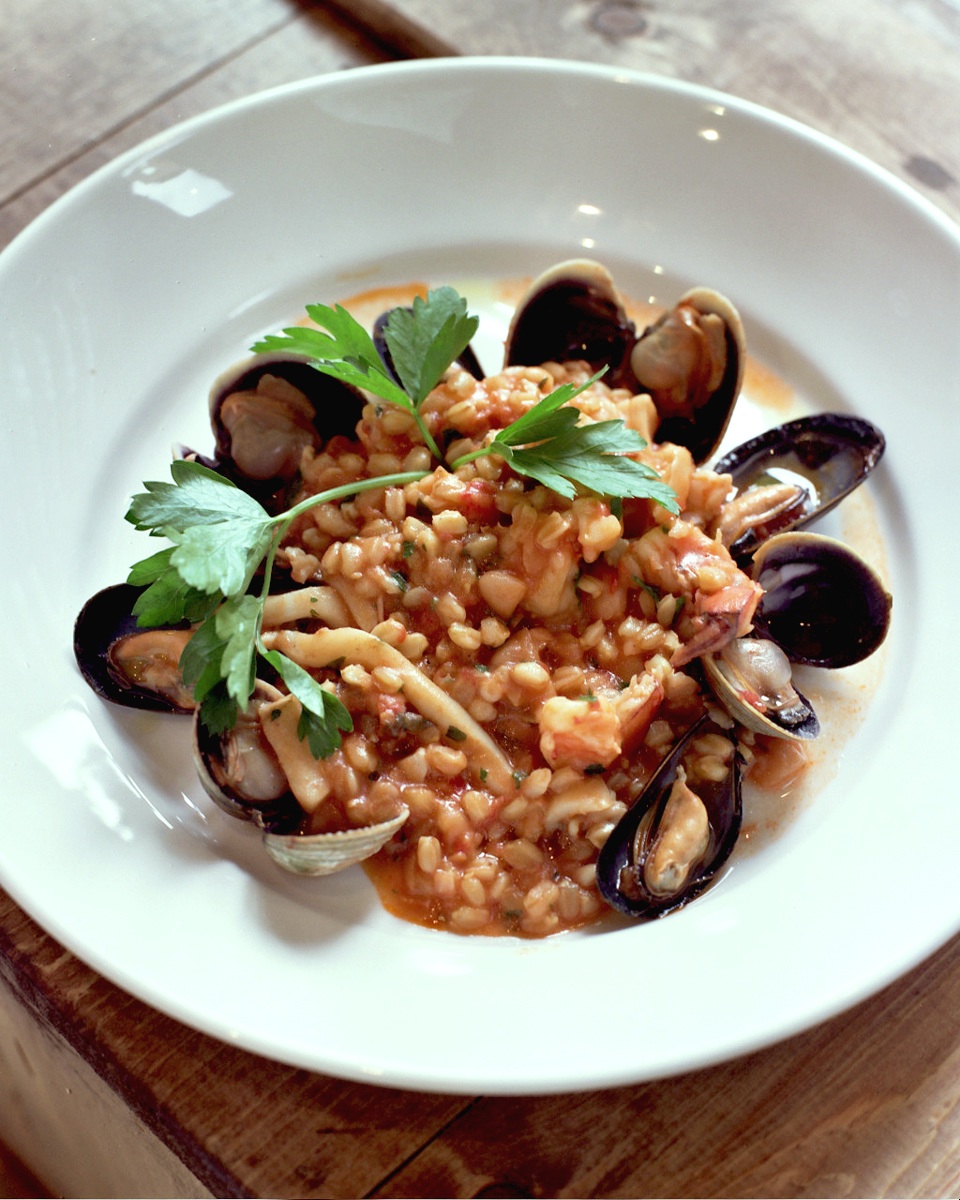 stronger every year but not top-loaded
with impossibly priced rarities (though they have some); instead there
is plenty of good wine under $50 a bottle.
stronger every year but not top-loaded
with impossibly priced rarities (though they have some); instead there
is plenty of good wine under $50 a bottle.
The best way to begin here is to share a
plate of antipasti--oozing
buffalo mozzarella, slices of salumi,
and
sliced cheeses, all at the right temperature--and the best fried strips
of zucchini in town, a big mound of greaseless, thin slivers you pop in
your mouth. A heftier starter is a portion of the freshly made
meatballs with tomato sauce, an item everybody loves and one that I'm
seeing showing up in the trendier new Italian spots around NYC now.
One f many stand-out farinaceous dishes
at La Masseria is the granotto
(right)--a Pugliese grain cooked till tender like risotto and
sharing the plate with a lush seafood sauce, mussels, and white
beans--a triumph of home-style Italian cooking! The fat bucatini strands of pasta are
mixed with "vecchia Roma"
sauce
of onions, pecorino, and bacon, while fresh orrechiette alla barese comes with
wonderfully bitter-salty broccoli di rabe and Italian sausage.
The owners' Caprese heritage is revealed in the raviolini (little ravioli) with caciotta cheese and a light tomato
sauce--as good as any I've had along the Amalfi coast--while potato gnocchi (a little too soft that
night) is
dressed in a rich sauce of taleggio cheese and radicchio.
 For main courses you may go as simply as
an impeccably grilled Mediterranean fish glossed with olive oil and
lemon or the roast rabbit alla
caprese with herbs and wine sauce. One of the very best
renderings of veal alla milanese
(left)--the
pounded veal chop lightly seasoned and perfectly sautéed to a
crisp
exterior and succulent interior--is the one done at La Masseria,
and it comes with an arugula and tomato salad. A massive veal T-bone
may also be enjoyed, cooked just the pint where the meat exudes all its
flavor. Even richer but not overly lavish is a nicely seared filet
mignon topped with fontina cheese and shavings of truffles in a
reduction of red wine.
For main courses you may go as simply as
an impeccably grilled Mediterranean fish glossed with olive oil and
lemon or the roast rabbit alla
caprese with herbs and wine sauce. One of the very best
renderings of veal alla milanese
(left)--the
pounded veal chop lightly seasoned and perfectly sautéed to a
crisp
exterior and succulent interior--is the one done at La Masseria,
and it comes with an arugula and tomato salad. A massive veal T-bone
may also be enjoyed, cooked just the pint where the meat exudes all its
flavor. Even richer but not overly lavish is a nicely seared filet
mignon topped with fontina cheese and shavings of truffles in a
reduction of red wine.
La Masseria's desserts are not out of the
ordinary in concept but their resolution puts to shame all those leaden
versions of ricotta cheesecake and tiramisù elsewhere, and their
warm apple tart with raspberry sauce and vanilla ice cream is one to
fight over at the table.
There was a time when I insisted that Italian
food in this country cannot be made as well as in the regions of Italy
where dishes have been based on the best local
ingredients. The availability of those same fine ingredients have
made the excellence of La Masseria possible, and, as my most recent
dinner there proved, the dedication of the owners and chef makes there
food as food as any in Campania, Puglia, or Rome right now. NYC
is very lucky to have La Masseria.
La Masseria is open
daily for lunch and dinner, and it's a great choice for pre-theater
dinner. At dinner antipasti run $8.50-$18.50, pastas (full portions)
$15-$28.50, and main courses $17.50-$38.50.
NOTES
FROM THE WINE CELLAR
My 10
Favorite (Affordable) Wines of 2008
by John
Mariani
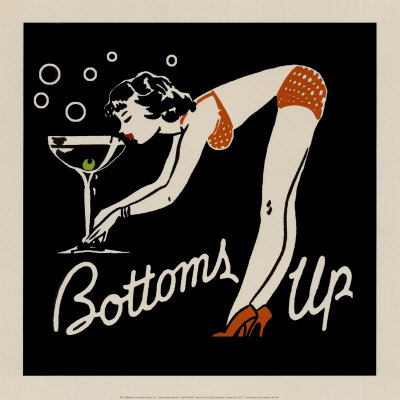 It’s
been said that in good times you deserve to drink a good wine, but in
bad times you need to. Fortunately, in 2008, more good wines at
reasonable prices came into the market so that there is no real cause
to suffer from what I call “Grand Cru withdrawal.”
It’s
been said that in good times you deserve to drink a good wine, but in
bad times you need to. Fortunately, in 2008, more good wines at
reasonable prices came into the market so that there is no real cause
to suffer from what I call “Grand Cru withdrawal.”
I’ve had so many terrific wines over the past year and few gave me much
pause to check my bank balance before buying a bottle. Here are my
picks—in no particular order--for the ten best of those I drank in 2008
and have every intention of enjoying in 2009. All are still
available in stores or online.
● Barbera,
especially from the Alba and Asti regions, have risen well above their
once pedestrian image, and one of the finest Piedmontese winemakers and
consultants, Renato Ratti, makes a big, beautiful, bountiful Barbera d’Alba Torriglione 2006
that ranks with more illustrious Piedmontese wines at three times the
price. At just $20, it brimmed with fruit and had the faint, farm-like
back taste I’d missed in so many other examples.
● A
vintage Champagne under $100 a bottle? Yes, indeed: Charles Heidsieck Blanc des Millenaires
Brut 1995 ($90) has just the right age on it for a blanc de
blancs to give it real character, which in this case is woodsy, not
musty, with none of that faint oxidation that can so easily push
vintage bubblies over the edge.
● Château
Rocher-Calon is a big, brawny Saint-Émilion from the
excellent
2005 Bordeaux vintage. It is as easy to enjoy right now for its
richness with a sirloin as with a honey lamb stew, and at about $19 a
bottle it is an outright steal. It will also take some aging, so at
this price, stock up.
●
Clos du Val has long
been one of my favorite California wineries, with more than three
decades of experience on their side, and it shows in the delightfully
crisp 2006 Chardonnay ($24) with its pretty vanilla notes. This is a
cool climate chardonnay, easily distinguishable from the overripe,
heavily oaked examples from other parts of Napa Valley.
●
American merlot has suffered from being too successful and from too
many wineries making too much of the stuff, but one of the first in
Napa to champion the grape was Duckhorn,
whose 2004 Estate Grown Napa Valley Merlot ($85) I would rank with the
finest from France’s Pomerol district, certainly a match for chateaux
like Clinet, L’Évangile, and Latour-Pomerol. Duckhorn tastes of
plums
and sage, with 5 percent cabernet franc blended in.
● Don Melchor’s 2002
cabernet blend shows at every level just how fine
the best wines of Chile can be—especially those from the Maipo Valley.
This is layered with spice, tannins, fruit, and acid in lovely
equilibrium and will taste even better next year and the next. At
about $50 it is a great wine for winter’s meats and game.
●
As Champagne houses go drier and drier with their wines, the sparkling
wine market elsewhere is retaining a commitment to the expressive
flavor of the grape itself, and Lucien
Albrecht Crémant d’Alsace Brut Rosé ($20) is pure
enchantment, with a medium-rich body and zesty effervescence enough to
drink with spicy Asian food. Nothing out of the Champagne region comes
close at this price.
●
Showing the magnificence of the nebbiolo grape, Marchesi di Barolo’s 2004 Barolo
($55) made me so happy that the traditional methods, combined with
modern technology, will always produce wines with the distinctive taste
of the terroir. The balance of alcohol and tannins is perfect, and
though young, this is a wine to drink with great pleasure right now and
to cherish having in the future.
● I’m
not ready to get overly excited by most current offerings of American
petite sirah, but the 2004
vintage made by California’s Ehrhardt
Estates Winery Clarksburg ($26) hits that sweet spot of price
versus value for the varietal, with good minty, peppery, mineral notes
and complexity throughout. The ideal wine for roast pork or a hot dog
slathered with strong mustard.
● I
drink more and more riesling these days because as the sweetness drops
away and Germany, Austria, Alsace, and America learn to make drier
styles with better balance of fruit and acid, I find them attractive as
aperitifs and as wines that go best with seafood. I particularly love Fritz Haag Brauneberger Juffer Sonnenuhr
Auslese ($35), a bold, bright, peachy wine as good with poached
trout as with a pan of hot chestnuts.
John
Mariani's weekly wine column appears in Bloomberg Muse News,
from which this story was adapted. Bloomberg News covers Culture from
art, books, and theater to wine, travel, and food on a daily basis, and
some of its articles play on the Saturday Bloomberg Radio and TV.
~~~~~~~~~~~~~~~~~~~~~~~~~~~~~~~
IS
THAT WHY THEY USE HARPOONS ON WHALES?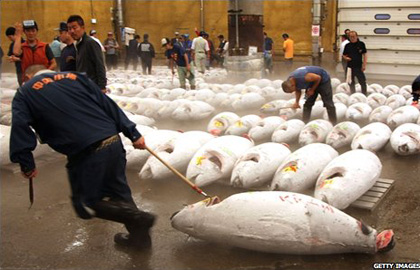
An Osaka-based
company has
begun using acupuncture on
sushi tuna to calm their stress, resulting in better texture and flavor.
LIKE,
YOU DON'T THINK ANY IDIOTS EVER THOUGHT OF THE BEER ANGLE?
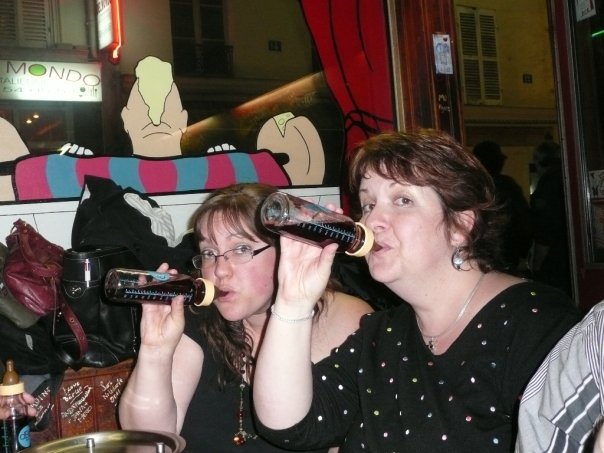
"Further to last month’s and yesterday’s intel about La Cave des
Fondus, the official word is now out, and we’re told that Jacques
Ouari's lounge was inspired by Refuge des Fondus, a joint in Paris that
serves wine in glass baby bottles (or biberons)
so as to avoid a tax on wine served in stemware. With its
`intentionally rude waiters,' the Parisian spot sounds kind of like the
French version of Dick’s Last Resort (by the way — how rude is an
intentionally rude French waiter?). It remains to be seen whether its
American knockoff will have similarly sadistic service, but it will
incorporate the baby bottles. Fun! But please kill us if we ever drink
beer out of a rubber nipple."--Bruce Palling in "More Intelligent
Life.com "in The Economist.
QUICK
BYTES
* Through Jan. 18, Restaurant Jean-Louis in Greenwich,
CT, is offering a “White Sale ,” taking 20% off its entire collection
of white wines. Call 203-622-8450.
* From now until Feb. 28 on the west coast and March 31 on the east coast, the Patina Restaurant Group will offer special winter wine pricing by taking 25% off all bottles. Restaurants incl. Café Pinot, Pinot Bistro, and Zucca, in California, and NYC’s Sea Grill list, Rock Center Café, and Brasserie 8. Visit www.patinagroup.com.
* Ken Frank, chef/owner
of La Toque restaurant at The
Westin
Verasa, Napa, is holding Ken Frank’s Truffle Camps limited to
eight students per session, to be held Jan. 11-14 and Jan. 18-21, incl.
3 days of dinners, wine tastings, luncheons, lodging, and hands
on experience preparing truffle dishes. Visit http://latoque.com.
* From Jan. 17-20th at Adour in DC, to honor the
inauguration, a “Black Truffle Menu” at $190 pp. Call 202-509-8000.
* On Jan.19 the 3rd Growers Dinner will be held at Jack Falstaff in San Francisco, when Chef Jonnatan Leiva invites Chef Lauren Kiino of Bracia in Oakland, local farmers and wine or beer producers to create and present a communal $85 meal. The Cavedoni Balsamic Vinegar Growers Dinner will feature balsamic vinegar from Cavedoni in Le Marche, Italy, with a selection of wines from Le Marche , Tuscany and Emilia Romagna. Call 415-836-9239 or visit www.jackfalstaff.com.
* From Feb. 10-14 Park Hyatt holds a 6-day "Masters of Food & Wine, South America" at Palacio Duhau–Park Hyatt Buenos Aires and Park Hyatt Mendoza, with chefs Coque Ossio from Peru and Fernando Trocca from Argentina, et al from Brazil, Colombia, and Uruguay, with cooking demos and tasting seminars. Rates pp from $1,165- $1,880 incl. 2 nights in Park Hyatt Buenos Aires deluxe room, transfer in and out, breakfast, opening cocktail, wine tasting and Rarities Dinner ; Park Hyatt Mendoza $2,000 -2,700. www.mfandw.com.ar or call 800-233-1234.
Everett Potter's Travel Report:

~~~~~~~~~~~~~~~~~~~~~~~~~~~~~~~~~~~~~~~~~~~~~~~~~~~~~~~~~~~~~~~~~~~~~~~~~~
Eating Las Vegas is the new on-line site for Virtual Gourmet contributor John A. Curtas., who since 1995 has been commenting on the Las Vegas food scene and reviewing restaurants for Nevada Public Radio. He is also the restaurant critic for KLAS TV, Channel 8 in Las Vegas, and his past reviews can be accessed at KNPR.org. Click on the logo below to go directly to his site.
~~~~~~~~~~~~~~~~~~~~~~~~~~~~~~~~~~~~~~~~~~~~~~~~~~~~~~~~~~~~~~~~~~~~~~~~~~~
Tennis Resorts Online: A Critical Guide to the World's Best Tennis Resorts and Tennis Camps, published by ROGER COX, who has spent more than two decades writing about tennis travel, including a 17-year stretch for Tennis magazine. He has also written for Arthur Frommer's Budget Travel, New York Magazine, Travel & Leisure, Esquire, Money, USTA Magazine, Men's Journal, and The Robb Report. He has authored two books-The World's Best Tennis Vacations (Stephen Greene Press/Viking Penguin, 1990) and The Best Places to Stay in the Rockies (Houghton Mifflin, 1992 & 1994), and the Melbourne (Australia) chapter to the Wall Street Journal Business Guide to Cities of the Pacific Rim (Fodor's Travel Guides, 1991). THIS WEEK: A Report on The Four Seasons Jackson Hole. Click on the logo below to go to the site.

Family Travel
Forum: The
Family Travel Forum (FTF), whose motto is "Have Kids, Still Travel!",
is dedicated to the ideals, promotion and support of travel with
children. Founded by business professionals John Manton and Kyle
McCarthy with first class travel industry credentials and global family
travel experience, the independent, family-supported FTF will provide
its members with honest, unbiased information, informed advice and
practical tips; all designed to make traveling a rewarding, healthy,
safe, better value and hassle-free experience for adults and children
who journey together. Membership in FTF will lead you to new worlds of
adventure, fun and learning. Join the movement.
All You Need to Know Before You Go
~~~~~~~~~~~~~~~~~~~~~~~~~~~~~~~~~~~~~~~~~~~~~~~~~~~~~~~~~~~~~~~~~~~~~~~~~
MARIANI'S VIRTUAL GOURMET NEWSLETTER is published weekly. Editor/Publisher: John Mariani.
Contributing Writers: Robert Mariani,
John A. Curtas, Edward Brivio, Mort
Hochstein, Suzanne Wright, and Brian Freedman. Contributing
Photographers: Galina Stepanoff-Dargery, Bobby Pirillo. Technical
Advisor: Gerry McLoughlin.
Any of John Mariani's books below
may be ordered from amazon.com by clicking on the cover image.
 My
newest book, written with my brother Robert Mariani, is a memoir of our
years growing up in the My
newest book, written with my brother Robert Mariani, is a memoir of our
years growing up in the For those of you who don't think of the Robert and I think you'll enjoy this very personal look at our --John Mariani |
 |
 |
 |
 |
 |
 |
© copyright John Mariani 2009
